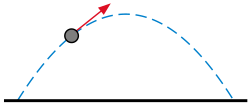
Back معادلة تفاضلية عادية Arabic Ecuación diferencial ordinaria AST Adi diferensial tənliklər Azerbaijani Ғәҙәти дифференциаль тигеҙләмә Bashkir Обикновено диференциално уравнение Bulgarian সাধারণ ব্যবকলনীয় সমীকরণ Bengali/Bangla Equació diferencial ordinària Catalan Obyčejná diferenciální rovnice Czech Дифференциаллă ахаль танлăх CV Gewöhnliche Differentialgleichung German

| Differential equations |
|---|
| Scope |
| Classification |
| Solution |
| People |
In mathematics, an ordinary differential equation (ODE) is a differential equation (DE) dependent on only a single independent variable. As with other DE, its unknown(s) consists of one (or more) function(s) and involves the derivatives of those functions.[1] The term "ordinary" is used in contrast with partial differential equations (PDEs) which may be with respect to more than one independent variable,[2] and, less commonly, in contrast with stochastic differential equations (SDEs) where the progression is random.[3]
- ^ Dennis G. Zill (15 March 2012). A First Course in Differential Equations with Modeling Applications. Cengage Learning. ISBN 978-1-285-40110-2. Archived from the original on 17 January 2020. Retrieved 11 July 2019.
- ^ "What is the origin of the term "ordinary differential equations"?". hsm.stackexchange.com. Stack Exchange. Retrieved 2016-07-28.
- ^ Karras, Tero; Aittala, Miika; Aila, Timo; Laine, Samuli (2022). "Elucidating the Design Space of Diffusion-Based Generative Models". Arxiv preprint. doi:10.48550/arXiv.2206.00364.
© MMXXIII Rich X Search. We shall prevail. All rights reserved. Rich X Search